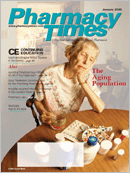Publication
Article
Pharmacy Times
Health Literacy Impacts Diabetes Outcomes
Author(s):
Health literacy is described as agroup of skills, including the abilityto perform the basic readingand numerical tasks, required to functionin the health care environment.1 Patientswho have poor health literacy skills mayhave problems that range from difficultyreading instructions on a medication bottleor interpreting blood glucose readingsto an inability to comprehend appointmentschedules or informed consentdocuments. In addition to reading comprehensionproblems, people with poorhealth literacy may have difficulty processingoral communication. Limitedhealth literacy can be a significant barrierto chronic disease management, especiallyin today's environment in whichscientific advances place greater technicaland self-management demands onpatients.
Poor health literacy is more commonamong patients who have low educationlevels and among immigrants, olderpatients, and racial and ethnic minorities.1 People with chronic medical conditionssuch as type 2 diabetes also tend tohave lower levels of health literacy.Little is known about the impact ofhealth literacy on clinical outcomes, but agrowing body of evidence suggests thatpoor health literacy contributes to pooroutcomes relative to glycemic control.2,3The results of these studies are significantfrom clinical and public health perspectives.Poor health literacy has been identifiedas an independent predictor of poorglycemic control and is associated with alower likelihood of tight control (definedas hemoglobin A1C [HbA1C] <7.2%).3HbA1C is a clinical end point that islinked to health care costs and disablingconditions.4,5 There is a well-describedlinear relationship between HbA1C andthe development of microvascular complications.5 A study by Schillinger et alfound that low health literacy is associatedwith a higher prevalence of retinopathyand other complications of diabetes.3
From a public health perspective, thestudy findings may have uncovered animportant variable that might helpexplain the prevalence of poor healthoutcomes among patients with type 2diabetes. A large portion of this populationis more likely to have poor health literacy,and 80% of these patients havecompleted only a high school educationor less.6
Pharmacists and other health careproviders often speak in terms that arenot understood by patients. Awarenessof this tendency is especially importantwhen counseling patients with poorhealth literacy. Identifying patients withpoor literacy can be difficult because theproblem can affect anyone, regardless ofeducational level. Patients often go togreat lengths to hide their inability toread or understand medical information.7Several tools are available that can helpproviders quickly identify the health literacylevel of the patient.8
There are a number of ways toincrease the likelihood of providing effectivecounseling to people who have diabetesand poor health literacy. Suggestionsfor counseling include the following:
- Using both oral and written informationas part of the education process;using pictures as much as possible;obtaining educational materials thatare written at or below a 6th gradereading level
- Creating a relaxed environmentwhere the patient feels comfortableasking questions. Body language isimportant—smiling, paying attention,and not crossing the arms (thisgesture suggests not being open forquestions).
- Speaking clearly and using short sentences
- Asking the patient to repeat instructionsto ensure that the messageintended is what he or she understands
- Offering adherence aids (eg, pillboxes)to decrease the likelihood ofadministration errors
Diabetes care requires that a numberof concepts and skills be conveyed bythe provider and successfully carried outby the patient. Diabetes self-managementis challenging for even the mosthealth-literate population. Awareness ofthe magnitude of the problem among thediabetic population provides an opportunityfor pharmacists to impact the outcomesof care for their patients.
Dr. Garrett is a clinical pharmacistpractitioner at Cornerstone HealthCare in High Point, NC.
For a list of references, send astamped, self-addressed envelope to:References Department, Attn. A. Stahl,Pharmacy Times, 241 Forsgate Drive,Jamesburg, NJ 08831; or send an e-mailrequest to: astahl@ascendmedia.com.







